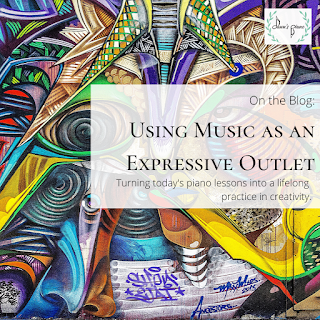Learning to use Music as an Expressive Outlet
One of the things that makes me happiest as a piano teacher is when a student comes in for lesson and tells me they were playing a song, just because. Maybe it helped them feel better on a hard day, maybe they were celebrating a good day, or maybe they just needed a mental break from another task and turned to music as a creative outlet, or even just a boredom buster. One of music's most valuable impacts in my own life is as a form of self expression, a safe place to work through tricky feelings and a space to exercise some creativity. In today's post I'm going to look a little closer at some of the ways we can be sure that students are learning to use what we do in piano lessons to express ourselves, so that when we eventually stop lessons, they'll retain music as a part of their expressive toolkit.
Play music you love. Compose. Improvise. The first step to connecting to music on a personal level is knowing what you like. Students should listen to music regularly, find what they enjoy, and then learn to make that kind of music. As we grow our own musical taste, we can start to create our own compositions or improvisations in the style of the music we enjoy, and deepen our sense of ownership and connection to musicianship as a form of self expression.
More about listening to music with your piano kid here.
Maintain a playlist. Keep active with music you've learned and have enjoyed playing. It's good to play through a handful of favorite songs every so often. I recommend having a folder of music that you turn to when you just want to play (and this is why students store all supplemental music in their lesson binders in our studio - so they have easy access to the music they know anytime they want to play it). You can definitely rotate the songs so that the playlist stays fresh. But it is always good to have some familiar favorites on stand-by for when you just feel like making music.
More in this blog post about maintaining a playlist.
Build sight reading & music theory fluency. One of best ways to stay motivated musically is to be able to play new music you're inspired by. When we hear a song on the radio, in a movie or video game, or see someone else perform it, we can be inspired to learn that music ourselves. In lessons we work on building the tools to sight read these new pieces, along with the music theory understanding to recognize patterns in music we hear and be able to pick them up by ear. These aren't just something we learn for the sake of learning them - they will become essential skills for students to be able to turn music as a personal creative outlet down the road.
More in this blog post about building sight reading fluency or click here for some of my favorite apps for music theory understanding
Practice turning to music as a form of expression. Like exercise, knitting cooking, reading, fishing or any of the other hobbies we turn to for our own enjoyment, there is an element of practice. I don't mean in rehearsing the music itself, but a practice making time to turn towards music when we are looking for that personal safe space. I personally have a rule that any music I play on the weekends is just for me and is not teaching related. (I can play this music throughout the week as well obviously, but the weekends are especially reserved for it) And I really look forward to sitting down each Saturday and just playing. Some weeks I gravitate towards familiar favorites, other times I pull out new music I want to learn, but the point I've is made a practice of having space to still enjoy music as a hobby and creative outlet alongside being a music teacher. To encourage this in your piano kid, consider having them choose one of their practice days where they just play music they feel like playing that day, or maybe at the end of each practice session they pick a song (or make one up!) that they just want to play for fun. This way they can keep music as that fun, creative outlet, while still being a student and growing in their musical journey.
